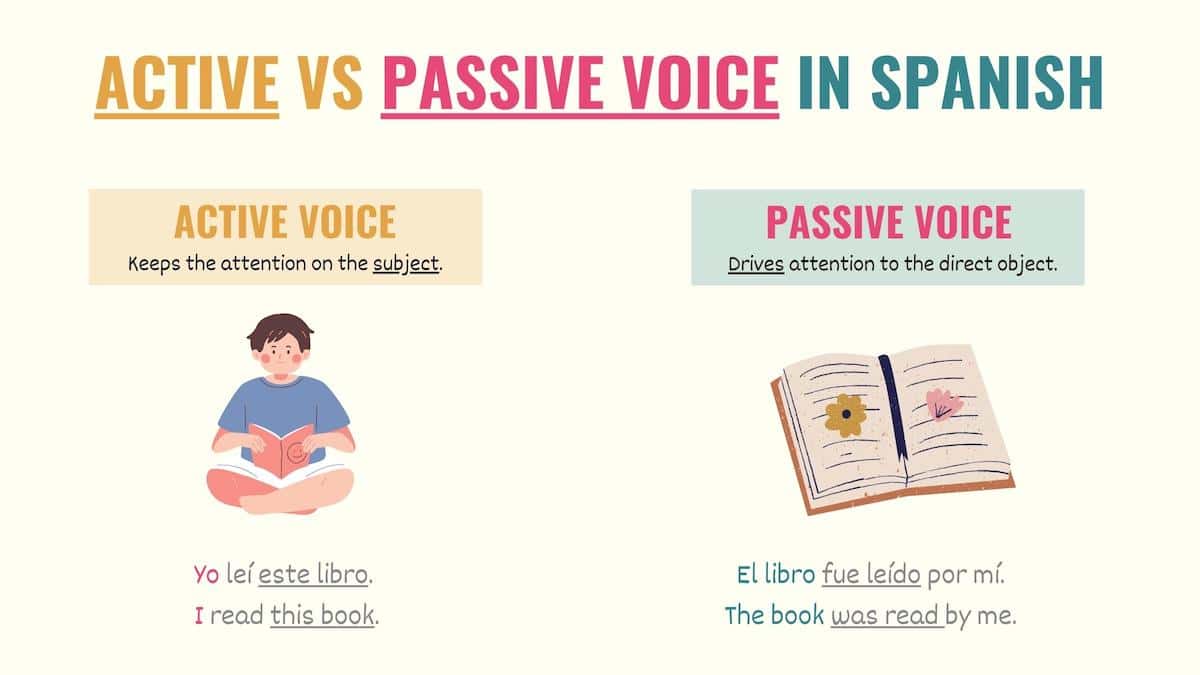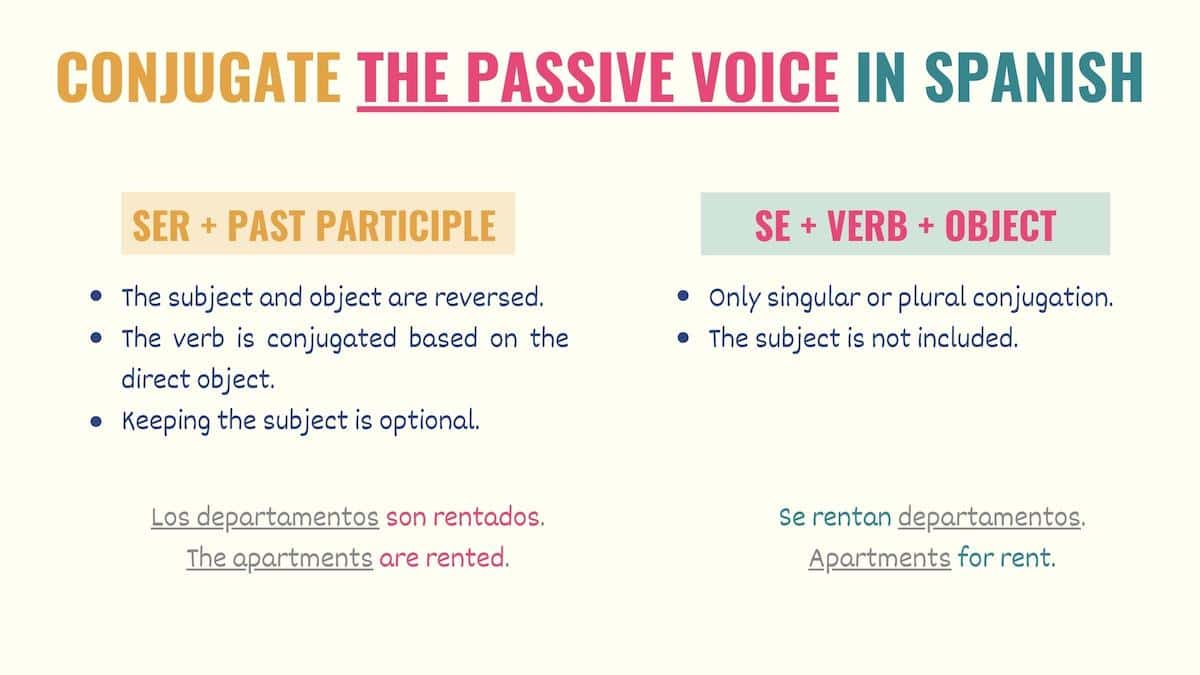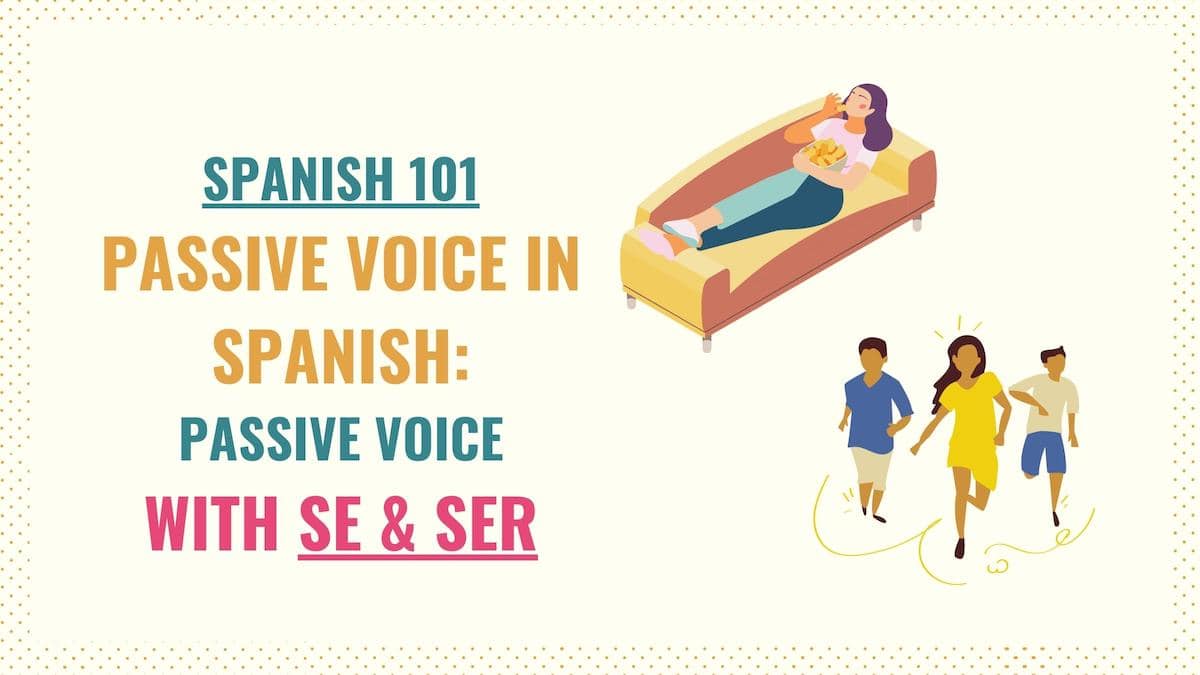Sentences with passive voice in Spanish are more common than you think. So, to help you get familiar with these structures, in this guide, we’ll go over the following:
- What is Passive Voice
- Conjugate the Spanish Voice with Ser
- Passive Voice with Se in Spanish
- When & How to Use the Passive Voice
- Key Points
- Downloadable PDF
Let’s get started!
What is the Spanish Passive Voice?
In Spanish, the voice of a verb describes the relationship between the:
- Action
- Subject (who performs the action)
- Direct object (person or thing receiving the action)
Active voice in Spanish communicates that the subject performs the action and an object receives it. We frequently use this voice to describe what we or someone else does. For example:
Ana leyó este libro.
Ana read that book.
Spanish passive voice occurs when the direct object becomes the subject of the sentence:
Este libro fue leído por Ana.
This book was read by Ana.

In the sections below, you’ll learn how to conjugate and use the passive voice in Spanish.
Take Note: One of the key elements to form the passive voice in Spanish is identifying the direct object of a sentence. Read this section on how to find a direct object in Spanish if you’re struggling with this topic.
Forming the Passive Voice in Spanish with Ser
This is the formula to conjugate the passive voice in Spanish:
[Direct object] + [ser conjugated] + [past participle] + por + (subject)
Let me break this down for you:
- Ser conveys when the action takes place and who is receiving it. Use the conjugation of ser that properly delivers this information.
- Verbs in past participle form describe the action. This is the main verb since it expresses what is happening.
- With the Spanish passive voice, past participles work as adjectives. So, they mark the direct object’s gender or number (singular or plural form).
- The order of direct object and subject is reversed. In other words, the direct object takes the subject’s place and vice versa. Adding the subject is optional.
You’ll find these elements in the sentence when transforming active voice sentences into passive voice. Check these examples:
| Example with active voice | Example with passive voice |
|---|---|
| Yo quebré las jarras. I broke the pitchers. | Las jarras fueron quebradas por mí. The pitchers were broken by me. |
| Mis hermanos venderán el carro. My brothers will sell the car. | El carro será vendido por mis hermanos. The car will be sold by my brothers. |
Notice that when changing these from active to passive voice, we must maintain the same Spanish verb tense. Check the sentences in the table above.
In example #1 with the active voice, ‘quebrar’ is conjugated to the preterite tense. Therefore, when changing to the passive voice, ser must be in the preterite form as well. The same happens in example #2 with the only difference that the verbs are in the future simple tense.
You can also create your sentences with the passive voice from scratch as long as you use the formula provided:
[Direct object] + [ser conjugated] + [past participle] + por + (subject)
El sospechoso está siendo arrestado.
The suspect is being arrested.
La pizza es preparada por el chef.
The pizza is prepared by the chef.
Spanish Passive Voice with Se
The passive voice in Spanish can also be formed with the pronoun se. With these structures, we must omit the subject. Additionally, the main verb can only be conjugated to the third person singular or plural. This conjugation must match the number of the direct object.
The formula to form the Spanish passive voice with se is:
Se + [verb in third person singular or plural] + [object]
Se solicitan empleados.
Employees are requested.
En México se habla español.
In Mexico, they speak Spanish.
Se renta departamento amueblado.
Furnished apartment for rent.
Be aware that the translations for these structures may vary. However, they never refer to a person in particular.

Take Note: The pronoun se in Spanish has other useful applications besides creating sentences with passive voice. So, don’t be confused if you see other structures that use this word.
When & How to Use the Passive Voice in Spanish
In Spanish, the passive voice is used to drive attention to the object (the person or thing receiving the action).
Simply put, there are occasions where the subject or person performing the action is irrelevant or not as crucial as the object. In such cases, we use the passive voice because it’s tactful or advantageous to drive attention to the object:
El acusado fue declarado culpable.
The accused was found guilty.
Take this sentence as an example. In this case, the news is that the accused was found guilty rather than who came to this conclusion. So, we must use the passive voice.
The same happens with passive voice with se. We care about the fact that this office is looking for a receptionist, not about who is looking for her:
Se busca recepcionista.
We’re looking for a receptionist.
Spanish passive voice is usually applied in written and formal contexts, such as essays, signs, news, etc.
Key Points
In this guide, we learned the passive voice in Spanish and how to use it. Here are some key points you should keep in mind:
- Active voice focuses on the subject, whereas the Spanish passive voice drives attention to the object.
- In Spanish, the passive voice can be formed with ser + past participle.
- With this structure, the direct object takes the place of the subject. This allows you to emphasize the person or thing receiving the action.
- When used in the passive voice, Spanish past participles have gender and plural form.
- The passive voice in Spanish can also be formed with the pronoun se.
- Passive voice with se omits the subject and only has a singular or plural conjugation.
Now, you’ve learned everything you need to know about passive voice. ¡Buena suerte!
Download the Passive Voice with Se & Ser PDF
Spanish grammar topics like the passive vs active voice can be difficult to learn due to the various rules involved with knowing which verbs to conjugate to the proper tenses, knowing how to reconstruct a sentence in a passive manner and so on. That’s why I’ve created a downloadable PDF for you containing all the graphics, key points and rules for understanding and using it.



